“My whole life was digging in the earth…That's when I really learned something about the earth, by digging deeper and deeper. Each layer is like another chapter of a book.” (artist Q.J. Stephenson, interviewed by Barry Gurley Huffman, 1988)
From the 1950s until his death in 1997, Q.J. Stephenson collected objects which surfaced in the course of his work as a dredger, trapper, and dragline operator in eastern North Carolina––including animal bones, fossils, iron ore, driftwood, shells, plant matter, and human-made artifacts––and incorporated them into a handbuilt cinderblock lodge constructed in the front yard of his Garysburg home.
As is recorded on an incised concrete plaque on the facade of the building, Stephenson became interested in displaying his natural collections for those in his community after returning from his work in the New Deal-era Civilian Conservation Corps, where he was trained to “fight forest fires, plant trees, and build trails” while stationed in California redwood country. Having learned a great deal about the workings of natural ecosystems during his time in the program, he built his lodge––called Earth Museum, Trapper’s Lodge, or Occoneechee Trapper’s Lodge––as an educational site for those in Northampton and Halifax counties. Those who visited the museum heard Stephenson lecture about the geological history of the region, local animal species (whose tracks he pressed into mosaiced concrete panels after trapping), and the value of indigenous philosophies. Natural objects and artifacts were worked into the concrete-coated facade and interior of the lodge along with identification labels, impressions of plants, glitter, and sculptures of invented and real creatures.
In the summer of 2023, I visited present Trapper’s Lodge / Earth Museum owner and steward Mike Spriggs for a tour of the site, which remains in Garysburg with much of Stephenson’s original decoration (save a handful of sculptures which have been acquired by local museums and the Smithsonian American Art Museum). In July of 2024, I caught up with Mike to discuss the present state of the museum, its continuing role as a teaching environment, the animal populations that continue to live around (and occasionally inside) the museum, and Spriggs’ own art practice.
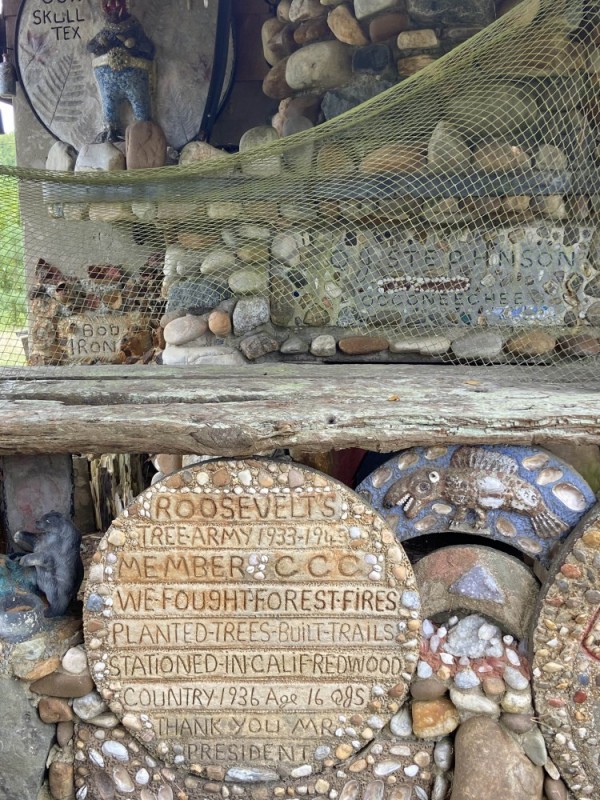
Q.J. Stephenson, Earth Museum / Trapper’s Lodge, August 2023, photograph by Gabrielle Christiansen
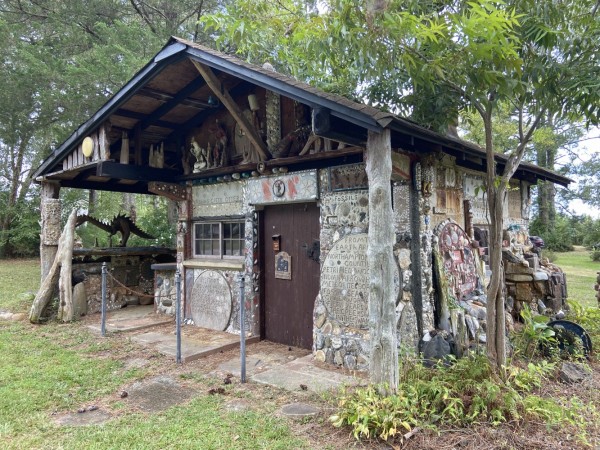 Q.J. Stephenson, Earth Museum / Trapper’s Lodge, August 2023, photograph by Gabrielle Christiansen
Q.J. Stephenson, Earth Museum / Trapper’s Lodge, August 2023, photograph by Gabrielle Christiansen
GC: I'm really curious to hear about a few things: Q.J. Stephenson's artwork and his role in the community in Northampton county, your role in upkeeping the Trapper's Lodge, how you came to be the owner, and finally, your own artmaking practice. I'll just start by asking: how did you come to make the decision to buy the property? What state was it in when you got the Trapper’s Lodge?
MS: Well, my wife's family actually owns some property just down the street. When we came out here to look at that, I pulled in the driveway here to turn around, and I saw a for sale sign on it. I got out and looked around the building, and I told my wife: “I want this.” Stephenson’s son came from Virginia down here to meet with me, and I told him that I wanted to fix it all back up and let people see it again. The house, nobody had lived in it for almost ten years. When I first got here, the whole front of the museum area was overgrown, so I had to spend several months just hacking and cleaning and removing bushes, discovering things all over the property.
GC: I'm remembering that you said your wife was from the area, right? I'm curious what her memories of Q.J. Stephenson were. I know you have visitors pretty often who went there as kids and come back as adults, too––do people have memories of him working and living on the site?
MS: Oh, yeah. There's little round mosaiced stepping stones all around the building that are covered with grass that he helped children in the area make and placed around the building. Nowadays, their children, grandchildren, even a couple of great grandchildren show up to try to find them. What I've done is left them semi-covered, and let them hunt for the right spot, because their grandparents or great grandparents told them where it would be. I let them uncover them, and they tell me stories.
GC: That's great. And your wife, did she come to the site, or she just heard tell of the house?
MS: Well, her grandparents were the ones that actually built the houses down the street. And when she was staying with them, she would come down here and visit it. But she said it was spooky as a kid.
GC: [Laughter] I bet.
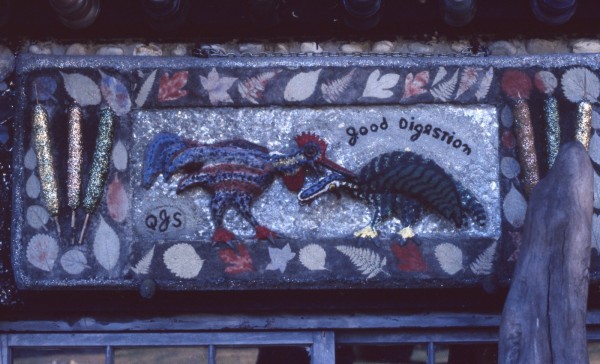
Q.J. Stephenson, mosaic on exterior of Earth Museum / Trapper’s Lodge, c. 2000, photograph by Gregg Blasdel ©SPACES Archives
MS: Back when he was here and alive, the whole front was covered with sculptures and totem poles all through the yard, and strange creatures. That's the stuff the Smithsonian's got. There was some other smaller pieces, but a lot of the local museums asked for it. They've offered it back to me, but I told them that I prefer they keep it. That way when people come in, they can tell them about the site and then they'll come here and look. I get people from all over the country: New York, Texas, Wisconsin, Chicago, Ohio, you name it. I even had one fellow from California.
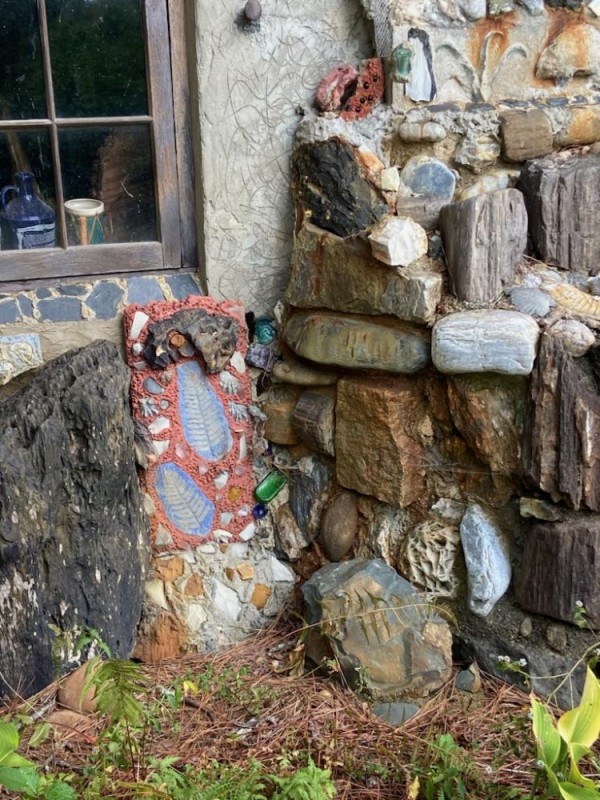
Q.J. Stephenson, Earth Museum / Trapper’s Lodge, August 2023, photograph by Gabrielle Christiansen
GC: It's a really cool site. One of my favorite parts of the Lodge is how Stephenson collected natural materials through trapping and through his line of work in Northampton County—the collection became a place of teaching visitors about the natural world through all those collections. Do you feel like people who visit come away with a better knowledge of the plant and animal species in the area?
MS: Oh yeah, there's always people that are surprised at the stuff that I show them, the different animals, especially when I explain to them that most of the animals were hunted and trapped right here within a mile or two. His family owned the house across the street, too, and most of the land back there was all wooded. People see the animal tracks in the mosaic works, and when I point out the different animals to them, they really get surprised. One lady freaked out when I pointed out the bear tracks and said that it was caught local. She didn't know they were here, and I hated to tell her, but they're very much around here.
GC: I wonder if the animal populations have changed much since Stephenson was at the site and making his pressings of beaver, otter, raccoon, bear, muskrat, skunk, mink. There has been a good amount of development in the area. Are most of them still around, would you say?
MS: The majority of them are. As a matter of fact, the majority of them are still coming onto the Lodge’s property. I went out to feed my outside cat the other day, and there was a possum sitting there looking at me over the food bowl. I had a raccoon trying to come in the back door not too long ago. The majority of the beavers are at the swamp to the south of us.
GC: I know in Q.J.'s time, the artist caught beavers for pelt-selling. At some point they got a bit overhunted, but now they're coming back, right?
MS: They're definitely on their way back, but I'm not sure they're totally back. When I go over here to the lake and go fishing, especially if I'm in my kayak, which is really quiet––I was out there a couple times and the beavers swim right up.
GC: Amazing. I love beavers, as somebody studying art and architecture. They're builders, one of those animals that have that instinct down pat.
MS: Sometimes they want to build in places that hurt people, but other than that, they're a beautiful animal to watch. They're great to have around, because they do actually help areas by making ponds, and they contribute to other animals’ populations. Speaking of other animals, I have a baby fawn playing in my front yard next to the museum at this moment.
GC: The babies are out right now where I'm at, too.
MS: Yup. Oh, there's five of them. Good thing I'm not a hunter anymore. I also have a large variety of snakes around here. I know a lot of people don't like them, but personally I think they're good––they also keep the rodent population down, so I encourage them. I've got one of those big black snakes that sneaks into the Trapper’s Lodge every now and then to shed his skin. One day when I walked up––you know the beams that run across the ceiling in there?––I went out there and opened the door, and I looked up, he was hanging right there. And I grabbed him, threw him out, and was cussing at him and carrying on. But I don't mind him. I just don't like him hanging over my head.
GC: Yeah, seems a little precarious. Maybe he saw all the animals mosaiced on the outside of the Lodge and wanted to sneak in. It’s nice that you foster a kind of self-organizing ecosystem at the site.
MS: My mom's people always said that you don't control nature, you live with it. And that's how I feel about it.
GC: That seems aligned with Q.J. Stephenson, from what I've read of his writing.
MS: From what I understand, he was also part Native American, and that's where he got a lot of his philosophy. My people were part of the Huron, up north. And so we were of two different tribes, but the same philosophers. Not just the wildlife––geological time should set humans straight, too. Stephenson got a chunk of volcanic rock mosaiced out here on the building––that was blown from a volcano over here in the mountains in North Carolina. That was millions of years ago. This area was underwater at one time, under the ocean. And that's where a lot of the aquatic material used in Stephenson’s artwork came from.
GC: That's part of why it's intriguing that a lot of the things Stephenson collected came from the dredging process—for better or worse, you get to see the layers of natural history that you don't always get to see on the surface. You get a sense of the past from that process. When you gave me a tour, you knew so much about all the materials on the outside of the house. Did that information get passed on to you when you bought the house? Or is that just from looking at things closely?
MS: A little bit of it is from experience, but a lot of it came from his family. He has a daughter; she used to come out here all the time, and she would take me around and show me the different things and tell me where her dad got it from.
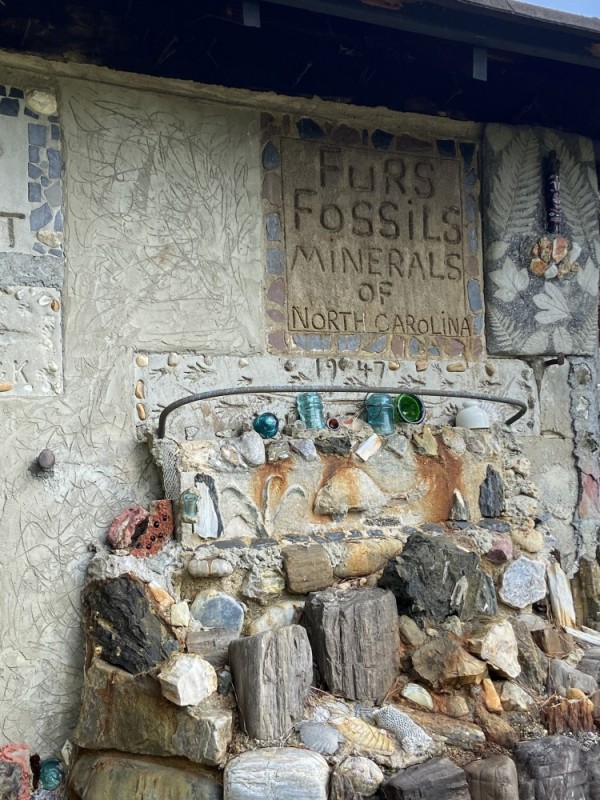
Q.J. Stephenson, Earth Museum / Trapper’s Lodge, August 2023, photograph by Gabrielle Christiansen
GC: I'm sure they were really relieved to have somebody who was invested in carrying on his legacy. It seems like they really wanted it to continue on as a site for people to visit and a site of education for kids.
MS: Yeah, that. And they liked the fact that I did artwork of my own. I gave them several pieces each. So they all have something.
GC: I would love to hear a little bit more about your artmaking. Can you tell me about what you make?
MS: Before, professionally, I used to destroy things, because that was my job. I got so sick of that that I wanted to create. I started out in a metal fabrication shop, so metal was the first thing I learned how to work with. And then I got into woodworking. I started making more and more stuff, and that's when I discovered how to do scroll saw work. After I got into doing it––I'd gotten patterns from people, and I still do––I discovered the joy of designing my own stuff. I get more enjoyment out of that than I actually do out of the stuff I make. I got into using my engineering degree, designing in programs like Autocad and Blender and other software like that. Now that I've gotten better at using it for art rather than making machine parts, I've got over six thousand patterns since you were here that are all mine.
GC: What kind of imagery are you working with lately?
MS: Whatever takes my fancy. I still do a lot from popular culture, but my wife loves the animals I make––frogs, turtles. So I've been working on more of that. All the local restaurants in Roanoke Rapids, if you go in there, you will either find some of my artwork or, if you ask, they'll know who I am and tell you about the pieces that they've got. Personally, I don't do this to make a fortune. I could probably make money making things, but it's so much more fun to give it away.
GC: It was nice to leave the site last year with some of your artwork to commemorate the occasion. I’m also curious to hear more about the recycled bottle process you mentioned to me a couple days ago that you’re incorporating into your artmaking.
MS: I’ve wanted to be able to rip down plastic bottles and the lids and make filament to use. I combined two different processes into a design plan—if it works out, I'll be able to process and make my own filament out of my scraps and bottles for three dimensional printing. Bottles, they're made out of what they call GT plastic, which is recyclable. But if you haven't checked the news and watched the videos, you'll see most of it is floating in the ocean now, where nothing's being done with it. I'd like to put a stop to that.
GC: We’re really reckoning with a garbage management crisis all around the world, and increasingly plentiful strategies for ways to try and make use of what’s discarded. I love how much you're able to create and give away at that site, and how you’ve found ways to save and reuse parts of Stephenson’s original mosaic works that are beyond repair. I still have a piece of petrified wood from the Lodge.
MS: Oh, people love that big piece of petrified wood that’s flaked off over time. One day, it might be gone, but until then, it's right there.
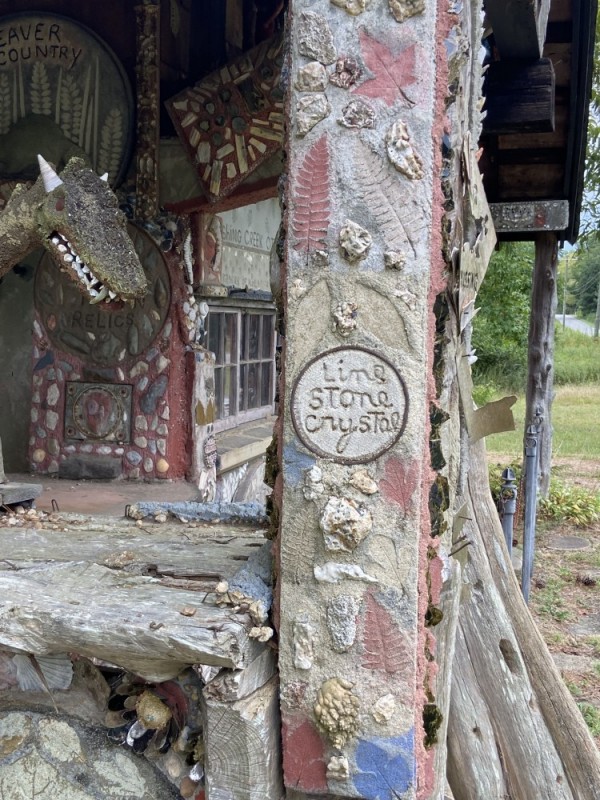
Q.J. Stephenson, Earth Museum / Trapper’s Lodge, August 2023, photograph by Gabrielle Christiansen
GC: Do you have many troubles with preserving the artwork in Stephenson’s museum? What's giving you the most trouble at the site?
MS: Mostly just the roof of the museum, and the house [both built by Stephenson]. I got to do the roof on it, too, so I'm just going to do both at the same time.
GC: Was Stephenson ever in construction? I’m wondering if the house and Lodge are well-built.
MS: The house is well built, but he actually wasn't trained in any sort of industry like that. He was self-taught, and then went from there. I think that's why he went with cinder block for building the house and museum, because it's so durable. His flooring, or his way of making floors, though, left a lot to be desired. There's a lot of waves in my floor. Part of it’s concrete, part of it’s wood.
GC: Ah. When you're self-taught, I'm sure it's a lot of trial and error.
MS: Oh, yeah. I’ve done the same thing with what I teach myself, so I know what he went through.
GC: I’m wondering too, regarding upkeep of the house and museum, about how much glitter he used inside of the lodge, in some of the mosaics––glitter is iconically hard to keep in one place.
MS: With that, for longevity, you wait till it's still damp but semi-dry, and you throw it on. Or you put it in the mold, and when you pull it out of the mold, it comes off with it. But a lot of the glitter you see on the building out here that Stephenson used, it’s actually not glitter. It's mica.
GC: Ah, nature's glitter.
MS: You can actually find sheets of it where you're from. If you go to the hill country and ask around, you'll probably find people that can say, “Oh yeah, you go up there and peel you off a few sheets.” You can't see through it very well, but it lets light through. So it acts like a stained glass. He used a little bit of both, plastic glitter and mica.
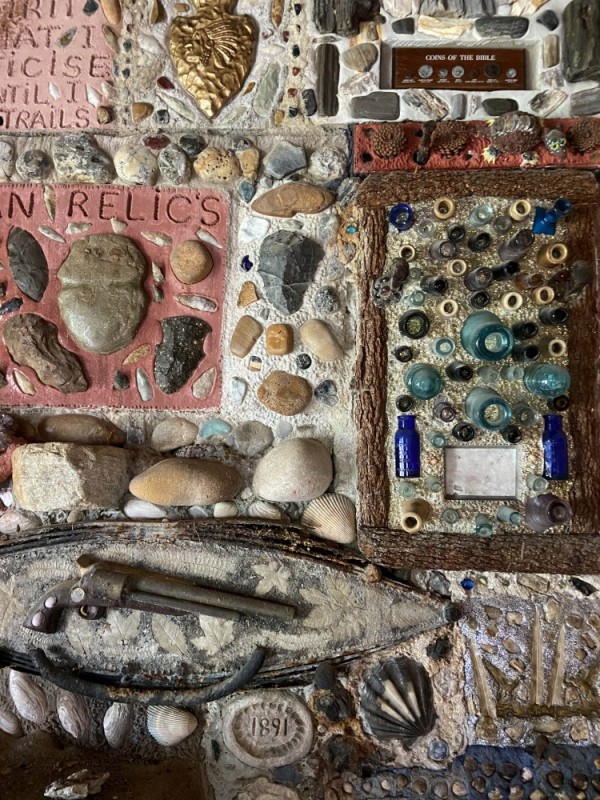
Q.J. Stephenson, interior detail of Earth Museum / Trapper’s Lodge, August 2023, photograph by Gabrielle Christiansen
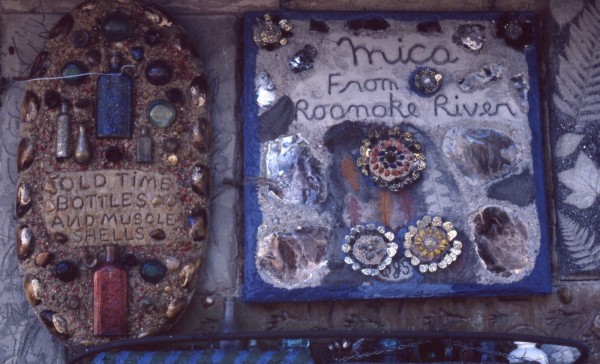
Q.J. Stephenson, mosaics on exterior of Earth Museum / Trapper’s Lodge, c. 2000, photograph by Gregg Blasdel ©SPACES Archives
GC: Very cool. Well, I really appreciate you talking about Stephenson’s materials, the site, your own artmaking. I don't want to keep you forever. I was wondering if you wanted to add anything as we wrap up about the best hours to visit, if people wanted to come to the Lodge in Garysburg.
MS: Anybody's welcome to walk around. But if they want me to come out and open it up, the best time is during the week when the sun's up. That way we can see what we’re doing. If I'm here, I'll come out and open it up. And if you stop in Roanoke Rapids or here in Garysburg––the post office, the police station, city hall–they’ll tell you: “Oh, yeah, that's just down the street.”
I’d like to extend enormous thanks to Mike Spriggs for his generosity and hospitality during our conversations and my visits to the Earth Museum / Trapper’s Lodge. Further information about the site can be found on its SPACES Environment page.
Gabrielle Christiansen is a PhD student in the Art History department at Northwestern University, where she studies 20th century vernacular artist-built environments of the United States. Most of the research she has worked on while at Northwestern has concerned global ecologies of detritus, acts of commoning on private property, and non-traditional modes of artistic pedagogy. She is working toward a dissertation project which considers the theories and policies of land use which have emerged through decisions to preserve or demolish artist-built environments in vernacular space.
Header image: Q.J. Stephenson, Earth Museum / Trapper’s Lodge, August 2023, photograph by Gabrielle Christiansen. Scroll saw work by steward Mike Spriggs visible on wooden facade.


Post your comment
Comments
No one has commented on this page yet.